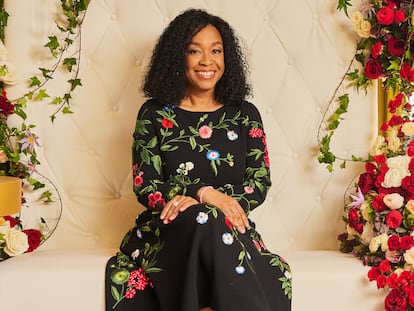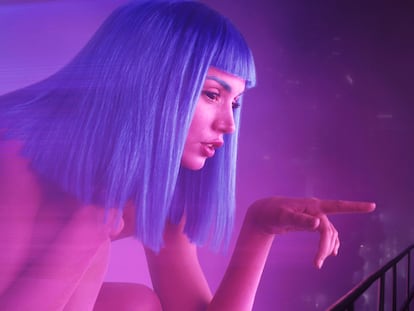Drew Barrymore’s umpteenth comeback: How she became the queen of confessional interviews
The actress — who was a child star, teenage addict, comedy queen and successful producer — has gradually become the face of a new kind, compassionate way of making television in the United States
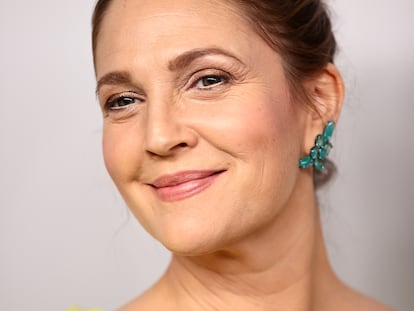
A few weeks ago, Jennifer Aniston and Adam Sandler visited The Drew Barrymore Show for what should have been a routine interview as part of the promotion of Murder Mystery 2, their new movie together. That was until the host began to show signs of nervousness and revealed to her guests, “I am so hot, I think I’m having my first perimenopause hot flashes.” The clip, which immediately went viral, received praise for the actress’s normalization of menopause, but also provoked a certain sense of nostalgia: those who still see her as the girl from E.T. were dismayed to discover that time waits for nobody.
Fans of the show, now in its third season on CBS, were not surprised that Barrymore talked about such an intimate event; instead of trying to conceal it, she grabbed her guests’ hands and made them (and the more than one million viewers who follow her daily) part of the moment. Her spontaneous gestures are commonplace: sometimes the actress goes barefoot and curls up on the couch, sits on the floor in front of her guest as if they were at summer camp, or lies down on the floor to be psychoanalyzed by George Clooney.
If there is one word that is repeated when talking about her show, it is tactile. Childish is another. Some of Barrymore’s attitudes have been the subject of mockery; moments like enthusiastically dancing in the rain, as if she were experiencing it for the first time, provoked malicious laughter, as well as a hilarious parody by Saturday Night Live comedian Chloe Fineman. But they also convey a sense that if anyone is entitled to reclaim their childhood, it’s someone who never had one. As writer Ashley C. Ford tweeted, “Nobody is healing their inner child harder than Drew Barrymore.” At 11 months old, Barrymore was in front of the cameras for the first time, at seven she was a star, and at 13 she was confined to a mental institution after a suicide attempt.
And on the seventh day...
Of all the actress’ comebacks, feel-good talk show star was the most unlikely. But there is something obvious about that evolution. Having been down in the mud herself has helped Barrymore draw out the innermost parts of her guests, many of whom have similar experiences to her own. For example, actor Jason Ritter, the son of John Ritter, discussed his drinking problems with Barrymore, confessing how they affected his relationship with his wife, Yellowjackets star Melanie Lynskey, and his fear that he wasn’t good enough for her.
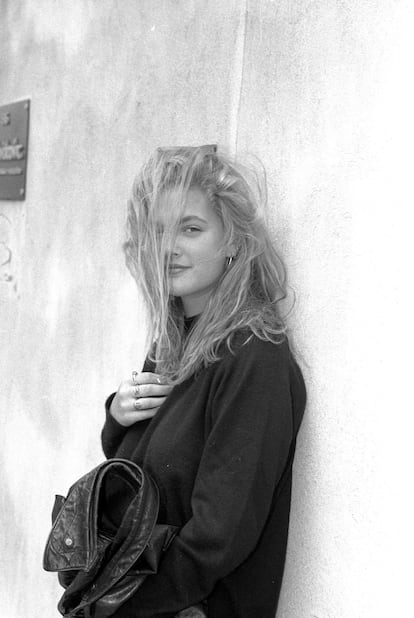
Contrary to the usual format, Barrymore didn’t try to make it any more tearful than it already was. Proudly, she recounted that she herself had gone almost four years without getting drunk, which she did regularly after her 2016 divorce from her third husband. “I’m not in rehab, but alcohol is my poison,” she said. The actress always exudes tenderness, fragility and absolute guilelessness. Viewers trust her because they have seen her grow up, while celebrities do because they know she is one of them. Critics are divided about her show, which they consider unclassifiable. The Drew Barrymore Show is too chaotic and unsettling to be fake. “She is not so much revisiting her past as dragging it along like a bindle full of lessons waiting to be discovered. If her off-the-cuff irrepressibility is an act, then it’s the best performance of her life,” Rachel Syme wrote in The New Yorker.
Barrymore still has much of the innocence of the little girl who once asked for a scarf to wrap around E.T. because she believed he was real, as the actress who played her mother in the film, Dee Wallace, revealed on the show. “We found you over there — just talking away to E.T. and so we let Steven [Spielberg] know. So, Steven, from that time on, appointed two guys to keep E.T. alive so whenever you came over to talk to him he could react to you.” Spielberg was something like a father to her. To surprise her on her 46th birthday, the show’s producers made a video call with the director, who told an emotional Barrymore, “Oh, Drewface, I still care about you… I’ve always cared about you, ever since the first time this little blonde hurricane walked into an audition in my office and took us by storm and then soon took the entire world by storm.” He then shared an anecdote that encapsulates their relationship. In 1995, when she appeared nude in Playboy, he sent her a layout of the magazine with a caption that read, “Cover up.” The director explained, “I had an artist come over and do paper doll clothes, which I glued onto all of the harshly exposed photographs and sent the whole thing back to Drew… and then, about a week later, Drew wrote me something, she sent me an apology [three photographs of Barrymore dressed up as a nun]… the first one was, ‘I’m sorry,’ the second one was, ‘I’ve seen the light,’ and the last thing was, ‘I’m on my way.’” He then showed the camera that he still has those three images framed and hanging in his home.
Hollywood royalty
E.T. made Drew Barrymore a celebrity when she was just seven years old, but she already had twenty commercials and a couple of movies to her credit. Her family is Hollywood royalty, and the Barrymore acting tradition goes back to 19th-century England. Her grandfather, John Barrymore, was a legend of classic Hollywood, as were her aunt and uncle Ethel and Lionel. Her father is less well known. He was an actor with an unremarkable career immersed in alcohol and drugs. John left home before her birth and Drew had little contact with him. Her mother, Hungarian-born actress Jaid Barrymore, raised Drew by herself but acted more like a manager and fellow partygoer than a parent. “I had a mom, but she was more like my best friend. She was like, ‘Do you want to go to school and get bullied all day, or do you want to go to Studio 54?’”
Aged nine, she was drinking, and at 12 she was snorting cocaine. She has never tried to sugarcoat her life. As she recounted in her autobiography Little Girl Lost, her mother called her a “loser,” an “asshole” and a “bitch” during a fight, and Drew slapped her. At the age of 13, following a suicide attempt, her mother sent her to a rehabilitation center. Against medical advice, she left the facility after two months, stole her mother’s credit card and went on a cocaine binge before Jaid hired private security to track her down and take her back to the clinic. At 15, she was legally emancipated. Her career was over, and she made a living serving drinks and starring in B movies.
Just when she seemed doomed to be another broken star in Hollywood, however, her career took off again and she unexpectedly became a romantic comedy star, stringing together hits such as Ever After, The Wedding Singer and Never Been Kissed, all minor classics of the late 1990s. Striking while the iron was hot, Barrymore set up a production company, which produced the highly successful film version of Charlie’s Angels (2000).
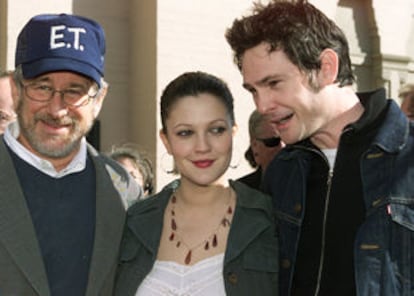
Barrymore is now following in the footsteps of legendary daytime talk show hosts, including the iconic Oprah, who went from poverty to the queen of afternoon TV and sounding like a candidate for the presidency of the United States, and Ellen DeGeneres, who after 19 years of success and 30 Emmy awards saw her show go off the air amid staff members’ allegations of a toxic work environment, racism and harassment.
Barrymore’s show first aired during the Covid-19 pandemic, and it served as a balm at a time when cynicism was rife. The program was not without its critics, but in its third season it seems to have come into its own and has given us a handful of viral and emotional moments. When actor and singer Jordan Fisher revealed his eating disorder, Barrymore knelt down in front of him, and they embraced. Her interview with Brooke Shields was equally candid; the two shared memories of growing up in front of the camera, giving up their childhoods, what it truly means to be “bad mothers” and surviving as a child in an adult world.
Actress and transgender activist Dylan Mulvaney, who has been the target of criticism from anti-transgender quarters for her Bud Light and Nike ad campaigns, also stopped by Barrymore’s show. As they discussed their tragic childhoods, the actress knelt before the influencer, a trademark gesture that drew furious attacks. “Women are now getting on their hands and knees to show solidarity with a man who has lived as a woman for less than a year. Truly the sneakiest trick the patriarchy ever pulled,” wrote Greg Price, communications director for the far-right Freedom Caucus.
Barrymore seems to have an endless capacity to open up. She doesn’t hesitate to reveal (and show) that she wears “granny panties” or talk about her lack of sex. When Andrew Garfield revealed that during the filming of Silence he had abstained from sex for six months, Barrymore replied that half a year didn’t seem very long to her. Days later, the conviction with which she mentioned her own sexless streak led a woman she met at the gym to tell her, “You look just like Drew Barrymore except you look like you have mental wellness and besides… she hates sex!”
The actress wanted to clarify her position, so she explained on her blog why she has not had sex in recent years. “I’m sure that there was one point in my life where six months might have seemed extreme, but I’m on the other side of that now. At nearly 48, I have very different feelings about intimacy than I did growing up. I did not have role model parents and I engaged with people in grown up ways since a tender age! I was looking for companionship! validation! excitement! pleasure! hedonism! fun! And adventures!! Now, because I can’t get in the time machine and change my history, I choose to look at it through a positive lens, which is that I lived! I lived a very rich, full life.”
Barrymore has been married three times: at 19, she was married to Los Angeles bar owner Jeremy Thomas for 39 days; her marriage to comedian Tom Green lasted slightly longer at 163 days. She was married to Will Kopelman, with whom she has two daughters, for four years. After their breakup, she hit rock bottom, which, of course, she has addressed openly on her show. She has stated that it was “cripplingly difficult.” She relapsed into drinking, and only the intervention of friends like Cameron Diaz — a constant in her life since they met at the bar where Barrymore was working at her career’s lowest ebb — helped her recover. But the idea of doing a daily talk show was the ultimate impetus to rehabilitate herself. “I think the opportunity at a show like this really hit me,” she said.
Sign up for our weekly newsletter to get more English-language news coverage from EL PAÍS USA Edition
Tu suscripción se está usando en otro dispositivo
¿Quieres añadir otro usuario a tu suscripción?
Si continúas leyendo en este dispositivo, no se podrá leer en el otro.
FlechaTu suscripción se está usando en otro dispositivo y solo puedes acceder a EL PAÍS desde un dispositivo a la vez.
Si quieres compartir tu cuenta, cambia tu suscripción a la modalidad Premium, así podrás añadir otro usuario. Cada uno accederá con su propia cuenta de email, lo que os permitirá personalizar vuestra experiencia en EL PAÍS.
¿Tienes una suscripción de empresa? Accede aquí para contratar más cuentas.
En el caso de no saber quién está usando tu cuenta, te recomendamos cambiar tu contraseña aquí.
Si decides continuar compartiendo tu cuenta, este mensaje se mostrará en tu dispositivo y en el de la otra persona que está usando tu cuenta de forma indefinida, afectando a tu experiencia de lectura. Puedes consultar aquí los términos y condiciones de la suscripción digital.
More information
Archived In
Últimas noticias
Most viewed
- Reinhard Genzel, Nobel laureate in physics: ‘One-minute videos will never give you the truth’
- Oona Chaplin: ‘I told James Cameron that I was living in a treehouse and starting a permaculture project with a friend’
- Pablo Escobar’s hippos: A serious environmental problem, 40 years on
- Chevy Chase, the beloved comedian who was a monster off camera: ‘Not everyone hated him, just the people who’ve worked with him’
- Why we lost the habit of sleeping in two segments and how that changed our sense of time

